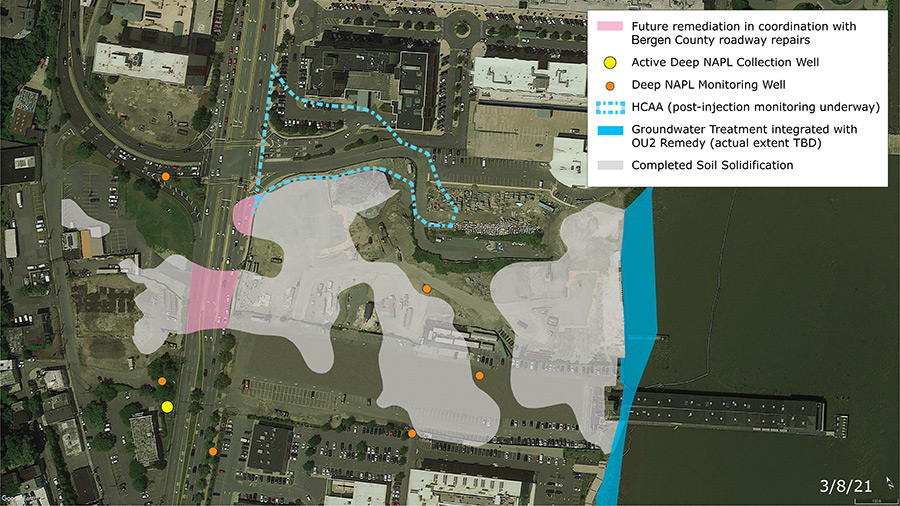EPA-Approved Cleanup Plan
After comprehensive environmental investigations and public input, EPA released its cleanup plan for soil and groundwater at the Quanta site in September 2011. Following is the status of each component of the plan:
- Soil solidification: In-place solidification of soil contaminants, a process that involves mixing cement into soil to permanently lock up heavy metals, coal tar, and waste oils so these contaminants cannot move.
- Status: In-place soil solidification was conducted from May 2017 to March 2021. Construction activities were idled to allow for the demolition of 115 River Road building from July 2018 through January 2019. During this time, Honeywell redesigned the remedy to include tents to eliminate odors and emissions. Construction activities completed prior to the demolition (May 2017 to July 2018) are called Phase 1 (no tents) while work completed after the demolition (April 2019 to March 2020) is called Phase 2 (with tents).
- Approximately 140,000 cubic yards of soil were treated on both sides of River Road. Soil remediation under River Road will be coordinated with Bergen County and the Borough of Edgewater. This work will take place under EPA's oversight.
- Deep collection well installation: Installation of a deep well recovery system to capture "non-aqueous phase liquid" (NAPL) - mostly coal tar and used oil - to guard against any potential future movement of that material.
- Status: Passive recovery wells were installed in 2015 and continue to be operated and/or monitored. Through the end of 2020, more than 2,400 gallons of NAPL have been removed and disposed at a permitted offsite facility.
- Groundwater barrier installation: Installation of a "subaqueous reactive barrier" to prevent contaminants in groundwater from reaching the Hudson River. A subaqueous reactive barrier is a permeable mat with a layer of reactive material in it. It will be placed on top of underwater sediments where contaminated groundwater will flow through it. As the groundwater moves through the mat, contaminants are trapped in it, and treated groundwater flows out the other side.
- Status: The groundwater barrier will be installed as part of the cleanup for the offshore portion of the site, known as Operable Unit 2 (OU2, see below.)
- High-concentration arsenic area (HCAA): Injection of zero-valent iron in the HCAA was completed in 2020, and post-injection monitoring is underway to verify the effectiveness of the treatment.
- Covering site with minimum of 6-inches of crushed stone or asphalt.
Operable Unit 2 (OU2)
The offshore portion of the site, including surface water and sediment in the Hudson River, is known as OU2. Investigation and remedial design for the cleanup of OU2 occurred separately from the soil cleanup on land. On September 27, 2024, EPA released a Fact Sheet and the Record of Decision for the OU2 remedy.


